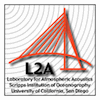About Us

History
The Laboratory for Atmospheric Acoustics (L2A) was established in 2002 by Michael Hedlin. The initial focus was on research in infrasound wind noise reduction and the design/installation of infrasound arrays as part of the new International Monitoring System, which is designed for monitoring compliance with the Comprehensive Nuclear-Test-Ban Treaty (see CTBTO). The group produced several papers on noise reduction, with a particular focus being the resonance problem in large rosette filters that are now a standard component of many sites in the IMS infrasound network. L2A also installed three IMS arrays (IS11, IS56, and IS57) and performed five site surveys (IS11, IS42, IS50, IS56, and IS57). Clint Coon joined the infrasound group in June 2001 before the inception of L2A. Catherine de Groot-Hedlin is a researcher that joined the group in 2006.
Research
Our research interests can be found here. Research statements can be found here for Catherine and Michael.
Environment
Research in L2A includes computer, lab, and fieldwork. Members of the group travel annually to national and international conferences presenting
results and periodically convening sessions (see News). Experiments are often conducted at IGPP, Camp Elliott (near Miramar, California),
and Piñon Flat Observatory (PFO). PFO is well known as a location with consistent moderate diurnal winds, and it has become a useful location for testing
wind-noise-reducing technologies. Camp Elliott is much closer to our offices than PFO and closer to acoustic sources such as Miramar and San Diego airports. By
the end of 2010, we will have five arrays located throughout the coastal states in the western U.S. Although we do not monitor these arrays for nuclear explosion
signals, these arrays stream data to our IGPP lab in near-real time so that we can monitor them for signals of scientific interest.











